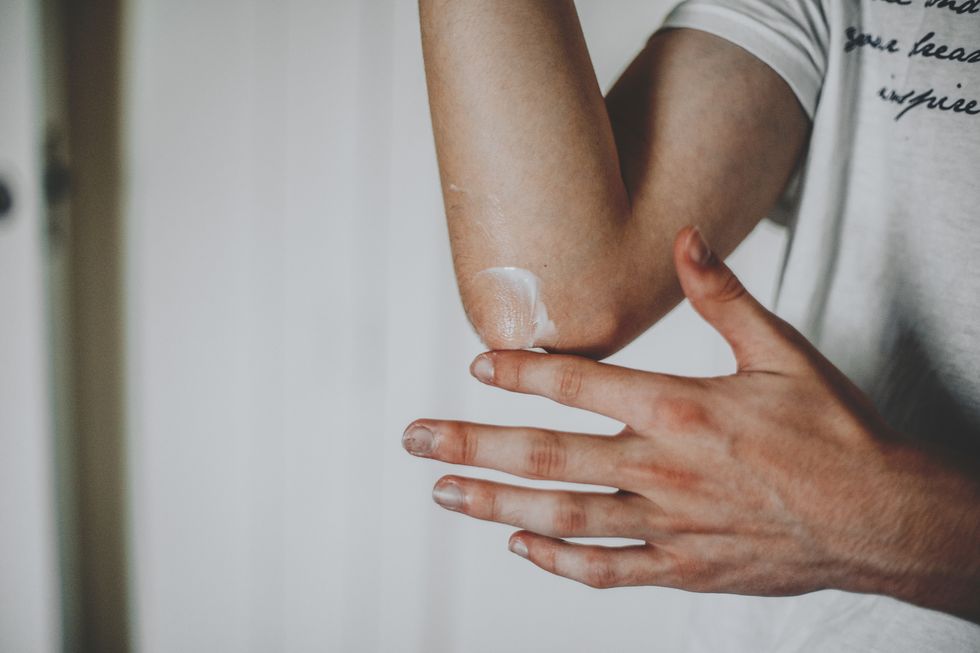[ad_1]
IF YOU NOTICE raised, red bumps on your skin that are incredibly itchy, you might have hives. Fortuately, they’re pretty easy to treat.
“Hives are usually due to an allergic reaction, and it occurs when mast cells release histamine,” explains board-certified dermatologist David Kim, M.D.
Here’s what happens behind the scenes: Your body stores the chemical histamine inside its cells, according to the American Academy of Dermatology (AAD). When you encounter a threat, your immune system releases histamine to protect yourself. The histamine release causes allergy symptoms, such as hives.
More From Men’s Health

The most common allergic reactions that trigger hives, also known as urticaria, are foods, bug bites, latex, medications, pet dander, plants, or pollen, according to AAD. Dr. Kim says the condition can also be caused by heat, stress, sunlight, or sweating.
Hives are sometimes confused with a rash, which refers to any irritated, red, or itchy spots on the skin, according to the Cleveland Clinic. Hives are actually a type of rash, but not all rashes are hives.
Hives appear as raised red bumps, welts, or splotches on your skin that can be large or small. They’re very itchy, but might also sting or burn.
The good news is that hives alone usually aren’t much to worry about. The condition typically lasts 24 hours or less, and you can usually treat it at home, Dr. Kim says. But, if your hives come with other symptoms, like a racing heart or difficulty swallowing, it’s likely signaling anaphylaxis.
“It’s an itchy, transient rash that swells but eventually goes away,” he adds. “People don’t often need prescription medications. Over-the-counter meds are typically sufficient.”
Here are several ways to treat hives, including when you should see your doctor:
1. Remove the Trigger
Since hives are caused by an allergic reaction, the first thing you should do is get away from what’s causing it, if you can, Dr. Kim says. Avoid animals if you’re allergic to their dander, foods that trigger reactions, and talk to your doctor if you notice skin blotches after you take a new medication.
2. Take an Antihistamine
Over-the-counter antihistamines are common hives treatments, says Heidy Hwang, Pharm.D., director of clinical services at UnitedRx Pharmacy. She suggests trying diphenhydramine (Benadryl), cetirizine (Zyrtec), or loratadine (Claritin).
“These over-the-counter medications work by reducing itching and swelling by blocking the body’s histamine response,” Hwang explains.
3. Try an Over-the-Counter Steroid
Topical steroids, like hydrocortisone, also help relieve the itching that comes with hives, Dr. Kim says. These creams or gels, which you can purchase at your drugstore, also reduce inflammation and skin irritation.
4. Use Calamine Lotion
You’ve probably used this iconic soothing pink lotion to treat poison ivy and bug bites. It works on hives, too, according to the Cleveland Clinic. Calamine lotion can relieve the itchiness of the condition, as well as any pain or discomfort that you have.
5. Apply a Cold Compress
The itchiness of hives can be uncomfortable and irritating. Applying a cold compress or icing areas that have hives can help, Hwang says. The coldness also reduces swelling and makes you a little more comfortable.
6. Use Arnica Cream
The herbaceous plant arnica is used to treat aches, inflammation, and wounds when applied topically as a cream, ointment, or salve, according to Mount Sinai. Dr. Kim says arnica can have calming effects, which reduces the itching and swelling of hives.
7. Take an Oatmeal Bath
Colloidal oatmeal has long been a home remedy for skin conditions like hives, since it has moisturizing and emollient benefits. Hwang suggests taking an oatmeal bath to treat hives. Mix a cup or so of colloidal oatmeal into your warm bath and soak for about 15 minutes.
8. Use Aloe Vera
Aloe vera is a common treatment for sunburns. Its anti-inflammatory and soothing properties heal hives, too, Hwang says. You can apply aloe vera cream or gel a few times a day.
9. Stay Cool
Heat can trigger hives and make them itchier, according to AAD. So, try to stay cool when you have the condition. Wear loose-fitting clothing, keep your home at a comfortable temperature, and avoid spending time in the sun.
10. Try Witch Hazel
The flowering plant witch hazel contains tannins and antioxidants, and it’s known to reduce inflammation and soothe the irritation that causes hives, according to the Association of Accredited Naturopathic Medical College. Apply witch hazel to your hives, leave it for 15 to 20 minutes, and then rinse it off.
11. Avoid Irritating Products
When you have hives, you want to keep your skin soothed and cool. “You should avoid products that may irritate the skin, like strong soaps and detergents,” Hwang says.
12. Ask About Light Therapy
If you have persistent hives and over-the-counter antihistamines stop working, talk to your dermatologist about light therapy, also known as phototherapy. AAD says it’s a non-invasive treatment that can help slow the growth of skin cells that can keep hives around. You’ll typically need weekly trips to your dermatologist’s office for about a month for treatment.
13. Stay Calm
Stress can be a hives trigger. The AAD recommends taking steps to minimize your stress levels, which can reduce instances of hives. That could mean exercising, meditating, doing yoga, or practicing other self-care activities.
14. Don’t Scratch
Hives itch, and you’ll definitely want to scratch. But don’t, Hwang says. The more you scratch, the worse the condition will get. Scratching will make your skin more irritated, and it might take longer to get rid of hives.
15. See Your Doctor
If you’ve tried over-the-counter medications and home remedies and your hives are sticking around for more than six weeks, call a dermatologist, Dr. Kim says. “Then, the diagnosis changes to chronic idiopathic urticaria,” or chronic hives.
Your doctor will review your medical history, the medications you take, possible illnesses, and exposures to things that can cause hives. Some diseases, like thyroid conditions, rheumatoid arthritis, or diabetes, can trigger hives, according to AAD.
In some cases, you might be prescribed an oral corticosteroid, like prednisone, or the injectable medication omalizumab.
16. Go to the emergency room if you have anaphylaxis
In extreme cases, hives can indicate a serious allergic reaction that requires immediate medical attention, Hwang says. Head to the emergency room if you have hives along with trouble swallowing, lightheadedness, swelling in your mouth or throat, or a racing heart. These could be signs of anaphylaxis, a severe allergic reaction that can be life-threatening.
Erica Sweeney is a writer who mostly covers health, wellness and careers. She has written for The New York Times, HuffPost, Teen Vogue, Parade, Money, Business Insider and many more.
[ad_2]


